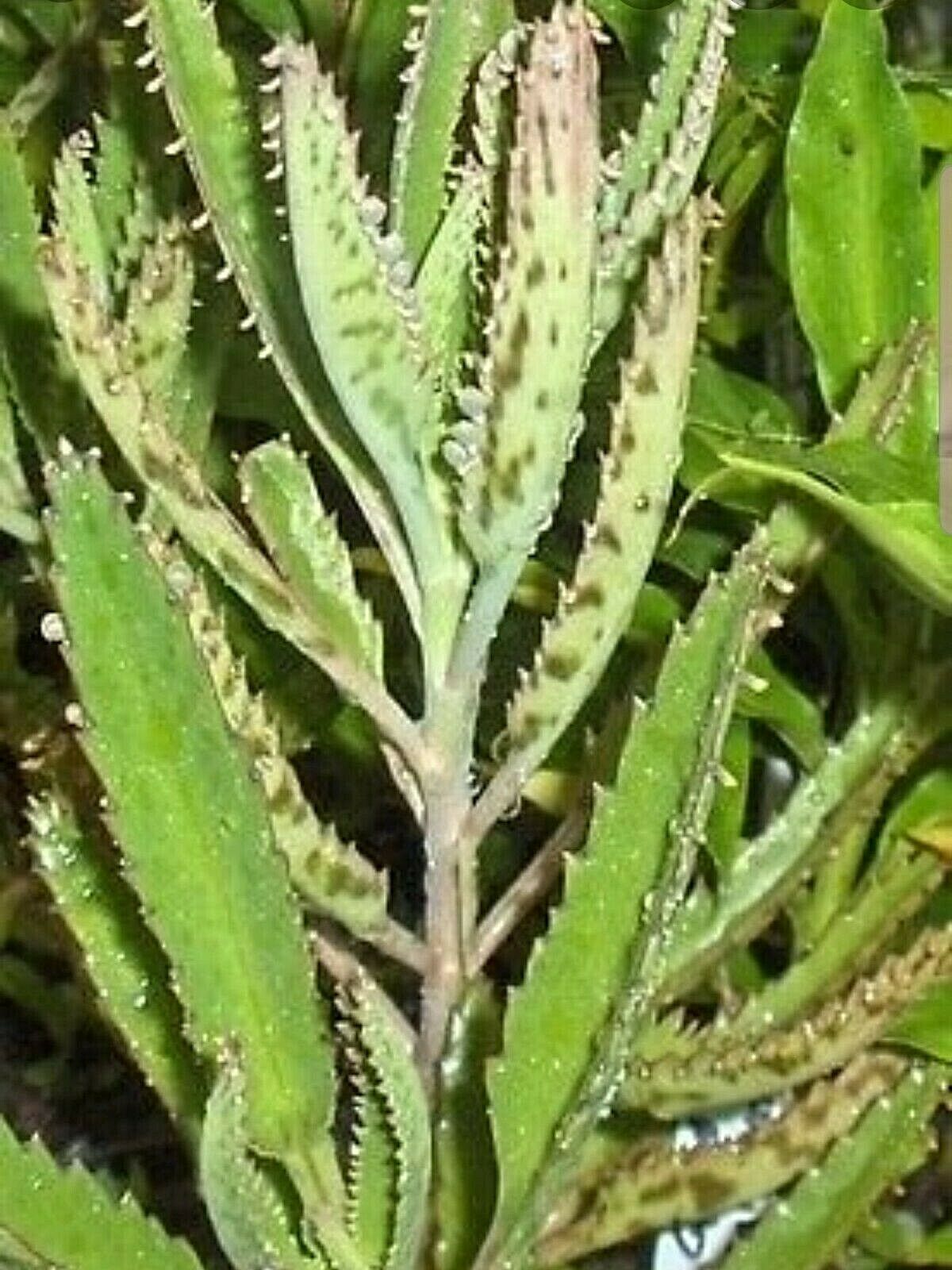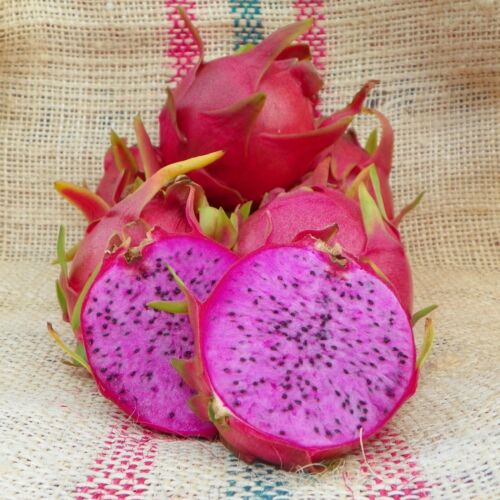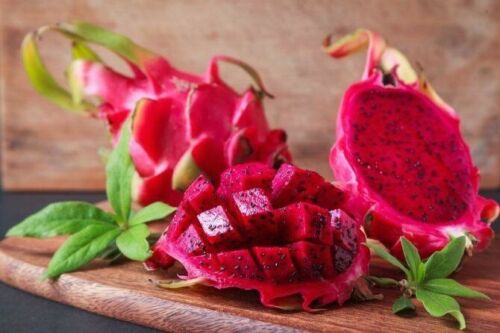-40%
Mothers of Thousands Alligator Live Plant, 3"- 6" STARTER (Succulent, Kalanchoe)
$ 4.75
- Description
- Size Guide
Description
'Mother of Thousands' Live, RootedSTARTER
Plant
3" to 6" long (including roots)
aka: '
Bryophyllum daigremontianum',
'Alligator Plant', 'Kalanchoe', Succulent
Description
Bryophyllum daigremontianum grows from a single unbranched stem 45-90cm (18-35 inch) tall, which carries opposite pairs of fleshy, shiny, lance-shaped leaves that are 10-25cm (4-10 inch) long. The leaves grow at an 8° angle to the stem and are bluish green with purple blotched undersides. The saw-toothed leaf edges curl slightly inward.
THE MAIN PHOTO SHOWS
A SAMPLE OF THE SMALL STARTER THAT WE WILL SEND
.
The other photos
show what your starter can look like upon maturity
The tiny plantlets "babies" that form in the gaps between the teeth often have tiny aerial roots attached. One leaf can carry as many as 50 such plantlets in a single season.
Pink flowers,
which bloom only on mature plant
, are roughly tubular, 2cm (0.8 inch) long and pendent. They are carried in rather flat clusters at the top of 30cm (12 inch) tall stalks in late autumn and early winter.
The plant dies after blooming. Flowering is, however, not an annual event and will occur sporadically if at all. Particularly in climates with distinct seasonal temperature differences, flowering is most frequently observed at the beginning of a warm season.
Bryophyllum daigremontianum take a year or two to mature.
Caring for a Mother of Thousands
This plant needs good drainage and is best potted in a commercial cactus soil mix. If using standard potting soil, sand can be added for sharper drainage. When learning how to grow Kalanchoe indoors, locate the plant in bright, but indirect light for several hours per day. When growing Kalanchoe outdoors, avoid direct afternoon sun. Houseplants will benefit from spending the summer outside; just make sure to introduce them to the outside atmosphere gradually and begin their outdoor stay with limited morning sun. Too much direct sunlight may cause leaves to become sunburned. Remember to move the plant back inside before outdoor temperatures drop to the 40 degree F. range. (4 C.). You will find that
growing mother of thousands is simple and mostly carefree
– a worthwhile gardening experience with limited care to keep it under control.
·
Houseplant care:
Bryophyllum daigremontianum requires minimal care and can tolerate dry conditions and high temperatures. It is an unusual, fast growing succulent.
·
Light:
These plants like bright light; do not subject them to direct sunlight.
(To be fair, many of these starter plants were retrieved from corners of the yard and spaces between driveway & sidewalk sections which were in full sunlight. We recommend that they not be INTENTIONALLY left in full sun if you wish them to mature and produce more)
·
Temperature:
Bryophyllum daigremontianum thrive in normal room temperature.
·
Watering:
During the active growth period water moderately, but allow the top centimetre (0.4 inch) or so of the potting mixture to dry out between watering. In the rest period water sparingly.
·
Feeding:
Apply standard liquid fertilizer once a month during the active growth period.
·
Potting and re-potting:
Use a soil based potting mixture. Move small plants into pots one size larger every spring. A Bryophyllum daigremontianum big enough to need 15cm (6 inch) pot is usually unshapely and best discarded.
·
Gardening:
Bryophyllum daigremontianum is not frost-hardy and typically dies if subjected to temperatures below freezing. Within its hardiness zone, Bryophyllum daigremontianum have the potential to escape from cultivation and spread into natural environments becoming a problematic weed. Therefore, precaution have to be taken when grow these plants in garden.
o
Newly transplanted Bryophyllum daigremontianum have the tendency to wilt. It is recommended to stake the taller ones to keep them growing straight until their roots are reestablished; these plants can be also planted deeper than the original root to give more support and promote more root growth. They will soon resume their growth.
·
Position:
Plant Bryophyllum daigremontianum in full sun or partial shade. Leaves will develop a pinkish-red color with lots of light, or will stay a greener color under less bright conditions.
o
It is very heat resistant, if planted in shade.
·
Soil:
Bryophyllum daigremontianum thrive in well draining, sandy soil. The plants establish well in leaf litter or other debris on shallow soils.
o
Space the plants 15-25cm (6–10 inch) apart to make room for the leaves to display their plantlets.
o
To promote new plants, do not mulch the ground around Bryophyllum daigremontianum. The plantlets which loosen from the plant will grow much better if allowed to fall directly onto soil rather than onto mulch.
·
Irrigation:
Water well when plant the Bryophyllum daigremontianum. After that these plants can be neglected or if watered, do so no more than once or twice a week. These succulent plants are adapted to dry conditions and can survive long periods of drought.
·
Fertilizing:
Use a water soluble fertilizer on Bryophyllum daigremontianum plants, following the directions given by the manufacturer.
·
Propagation:
Plantlets growing at the base of the plants may be dug up at any time, replanted in 5-8cm (2-3 inch) pots of standard potting mixture and treated as mature plants. Or plantlets may be picked from the leaves and shallowly planted in standard potting mixture.
·
Problems:
Bryophyllum daigremontianum is generally problem free, but their succulent leaves are a great attraction for insects like mealy bugs, scale or aphids.
o
Treatments:
Control mealy bugs by wiping the infested leaves with a cotton swab dipped in alcohol. Remove brown scale insects by gently scraping them off. Aphids should be removed by hand. Isolate plants that show signs of insect pest infestation to prevent infestation of other plants.
o
Prune tall growth and old flower stems and allow plenty of air flow around your plant to avoid powdery mildew.
o
If the plant becomes infected with powdery mildew, potassium bicarbonate can be used to control it. If rot affects the plant, it normally starts at the root.
o
It is recommended to discard affected plants and start new ones from plantlets.
·
Toxicity:
Do NOT INGEST!
o
A
ll parts of the Bryophyllum daigremontianum plant are poisonous (they contain daigremontianin and other bufadienolides), which can even be fatal if ingested by infants or small pets. It is also poisonous to humans.
USPS First Class shipping is
included
in purchase price
















